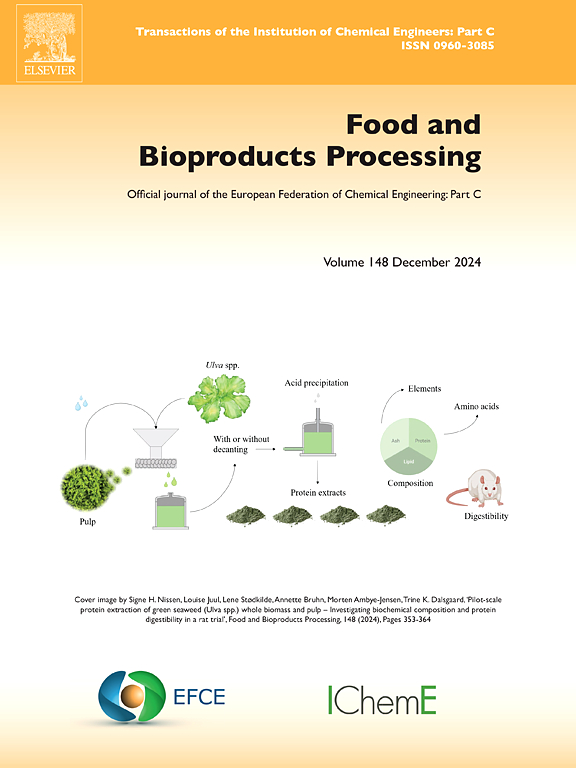间歇式加压液体萃取法作为药用植物酊剂生产的新选择——百香果叶水醇提取物的生产规模和经济评价
IF 3.5
2区 农林科学
Q2 BIOTECHNOLOGY & APPLIED MICROBIOLOGY
引用次数: 0
摘要
本文研究了间歇加压液体萃取法提取西番莲叶提取物的工艺流程,并对其进行了规模模拟和经济评价。在实验室规模下,使用70 %乙醇(v/v)混合物,在80 °C下,每次静态循环100 %溶剂更新,5个循环,6 min的静态时间,获得最高的提取效率。在保持重要工艺变量和溶剂质量/进料质量比恒定(S/F= 4.25)的情况下,进行了放大研究。这种放大方法被证明是有效的,从实验室规模扩大到中试规模(从34 mL到2 L)。用中试设备提取,总固含量为35.6±1.5 %,溶液用量约为3768.4±121.3 mL。尽管时间不同,但两种尺度的提取曲线相似。使用SuperPro Designer®8.5版软件模拟制造成本(COM)、盈利能力分析、投资回报率、毛利率和投资回收期。评估了五种提取系统,其中四种系统使用2个提取池在半连续系统中,容量为2、10、50和100升,另一种系统使用只有1个提取池的批处理系统。结果表明,工业规模的设备如果在半连续状态下(2个萃取池)运行,只有两个萃取周期,则具有较低的COM,具有竞争力的市场价格。本文章由计算机程序翻译,如有差异,请以英文原文为准。
Pressurized liquid extraction (PLE) in an intermittent process as a new alternative for production of tincture from medicinal plants: The scale up and economic evaluation for production of passion fruit (Passiflora edulis Sims) leaf hydroalcoholic extract
This work involves the simulation of scale-up and economic evaluation of the production process of passion fruit leaf extract (Passiflora edulis Sims) through intermittent pressurized liquid extraction. The highest extraction efficiency was achieved using a 70 % ethanol (v/v) mixture on a laboratory scale at 80 °C with 100 % solvent renewal per static cycle in 5 cycles and 6 min of static time. A scale-up study was conducted, keeping both the significant process variables and the solvent mass/feed mass ratio constant at (S/F= 4.25). This scale-up method proved effective for scaling from laboratory to pilot scale (from 34 mL to 2 L). Extraction with the pilot-scale equipment yielded total solids ranging from 35.6 ± 1.5 % with a consumption of around 3768.4 ± 121.3 mL of solution. The extraction curves were similar for both scales despite different times. Manufacturing Cost (COM), Profitability Analysis, Return on Investment Rate, Gross Margin, and Payback Time were simulated using SuperPro Designer® version 8.5 software. Five extraction systems were evaluated, with four using 2 extraction cells in a semi-continuous system with capacities of 2, 10, 50, and 100 liters and one in a batch system with only 1 cell. The results demonstrated that industrial-scale equipment has a lower COM if operated in a semi-continuous regime (2 extraction cells) with just two extraction cycles, presenting a competitive market price.
求助全文
通过发布文献求助,成功后即可免费获取论文全文。
去求助
来源期刊

Food and Bioproducts Processing
工程技术-工程:化工
CiteScore
9.70
自引率
4.30%
发文量
115
审稿时长
24 days
期刊介绍:
Official Journal of the European Federation of Chemical Engineering:
Part C
FBP aims to be the principal international journal for publication of high quality, original papers in the branches of engineering and science dedicated to the safe processing of biological products. It is the only journal to exploit the synergy between biotechnology, bioprocessing and food engineering.
Papers showing how research results can be used in engineering design, and accounts of experimental or theoretical research work bringing new perspectives to established principles, highlighting unsolved problems or indicating directions for future research, are particularly welcome. Contributions that deal with new developments in equipment or processes and that can be given quantitative expression are encouraged. The journal is especially interested in papers that extend the boundaries of food and bioproducts processing.
The journal has a strong emphasis on the interface between engineering and food or bioproducts. Papers that are not likely to be published are those:
• Primarily concerned with food formulation
• That use experimental design techniques to obtain response surfaces but gain little insight from them
• That are empirical and ignore established mechanistic models, e.g., empirical drying curves
• That are primarily concerned about sensory evaluation and colour
• Concern the extraction, encapsulation and/or antioxidant activity of a specific biological material without providing insight that could be applied to a similar but different material,
• Containing only chemical analyses of biological materials.
 求助内容:
求助内容: 应助结果提醒方式:
应助结果提醒方式:


